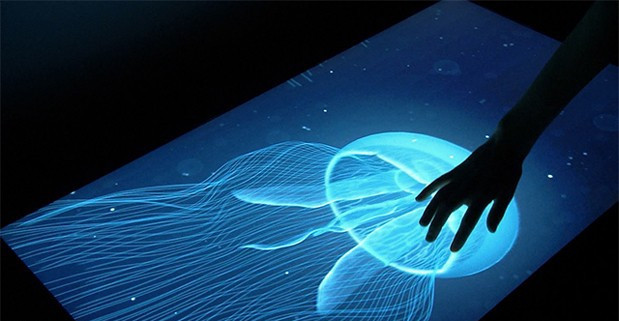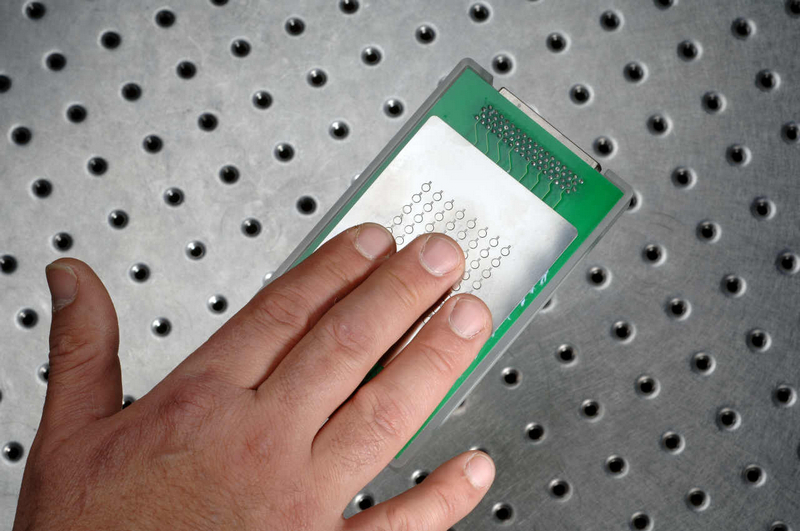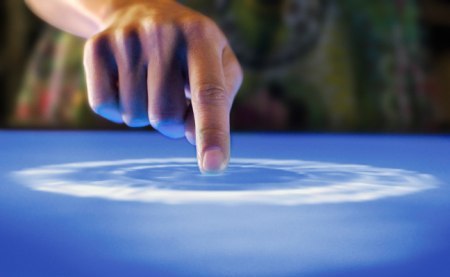How tactile interfaces will change our gadgets

Feedback tactile communication is present in gadgets for quite a long time. Most often, it is represented in smartphones and joysticks of game consoles in the form of "vibrating alert" and response vibration in response to user actions. Duplication of incoming calls, reminders and jitter when shooting and explosions, are the most common uses for the tactile function. And the overwhelming majority of users do not imagine any other ways to use this communication channel.
However, there are several ways to use this method of interaction and obtaining information from devices. More precisely, these three directions. And their widespread use in mass electronics will give users a qualitatively new experience in using seemingly familiar gadgets. This marks the beginning of a new stage in the development of consumer devices, aptly called the " non-sensory era ."
')
The first way to use tactile feedback is to expand the range of tactile sensations from using gadgets. The second method is the transfer of specific template information. The third way is communication. Consider each of them in more detail.
Expansion of the range of tactile sensations
The other day, Amazon has released five new devices, two e-ink readers, and three tablets. And the most interesting device is the Kindle Voyage premium reader.
What is it remarkable? On both sides of the screen, whose surface texture resembles paper, there are touch zones for page turning. At the same time, the flipping itself is initiated not by the usual touch or sliding gesture, but by a slight compression of these sensory zones. When a page is “flipped”, the device accompanies it with a vibration similar to that which occurs when paper pages slide along each other.

By the way, in the first YotaPhone, we also experimented with tactile feedback when using the touch zone under the second screen. When turning the pages with a gesture of sliding, the smartphone vibrates pleasantly. In the second YotaPhone will be fully touch the second screen, which gives much more features. Therefore, we developed completely new scenarios for using the second screen, which you will learn about after the presentation of the smartphone.
Another example of a new approach to using tactile communication is the Apple iWatch, which will go on sale next year. They integrate the so-called "Taptic engine" (a combination of the words tap (touch) and haptic (tactile)), a kind of physical response to user actions. For example, when you turn the head of the “plant”, you immediately feel a specific vibration, like dancing on your wrist, adding unusual sensations when using this mechanical control. When you swipe your finger across the screen, press the button next to the head, or perform some other action, the Taptic engine generates specific tactile responses that accompany it at the level of sensations .

Do not stay aside from the new direction and sworn friend of Apple, Samsung. Koreans recently introduced a series of multi-function smart printers MultiXpress , equipped with a "tablet" interface with a variety of tactile communication.

All these aforementioned devices use the advantages of a new direction in engineering, called haptography ( haptic + photography , can be translated as "tactilography"). It involves recording and recording physical sensations with subsequent reproduction. In fact, this direction is at the very beginning of its formation. With its further development, a new dimension will become available to users in collaboration with gadgets. For example, we can feel the texture of the surface of objects that we see on the screen or hear from the speakers. Modern lifeless displays of smartphones and tablets come to life, will literally respond to touch. All kinds of interfaces, from dashboards of cars to doors of refrigerators and remote controls, will “touch back” on our touch. And this tactile "responsiveness" will almost fascinate.
Transfer of specific template information
The Apple iWatch also has a mechanism for transmitting specific sample information. For example, if you follow a route laid out in a map application, the watch will warn you to turn by vibrating with the right or left side, so you don’t even have to look at the screen.
The new hybrid car Mersedes S550 will transmit tactile information by vibrating the floor under the driver’s feet. For example, in this way the car will prompt you to reduce the gas in order to save fuel or charge the battery. Another type of vibration of the driver will inform about switching from the electric motor to the engine.
Wearable devices like smart glasses (which, unlike a Google product, will look like ordinary glasses) will vibrate slightly, warning the user that any specific information has come into view.
Communication
Perhaps communicating with people is one of the most interesting ways to apply tactile feedback. And here we must again mention the Apple iWatch. If you select someone’s contact from the list of favorites and then touch the screen, that person will feel this touch through the specific vibration of their Apple iWatch instance. You can even send your heartbeat to another person, while the sender and the recipient will see a pulsing heart on the screen, and both will feel its rhythm on their wrists. By the way, perhaps in the Russian language with time such a vocabulary will appear, as “I feel the clock”.
This idea is also used in many startups, for example, in the Tactilu bracelet, which transmits “touch” from one user to another.

Of course, this property will soon be introduced into smartphones. Perhaps it will even reach the standardization of a certain “tactile protocol”. Surely there will be custom vibrocircuits, similar to the melodies for calls and SMS, so it will be possible to understand who is calling you, simply by the specific vibration chosen for this contact.
The most surprising thing about this perspective is not indulging lazy users who do not even want to look at the phone screen, but in a new psychological experience, somewhat reminiscent of telepathy, when you, at first moments even unconsciously, suddenly “feel” the attention of another person.
How tactile feedback improves user experience
We are now standing at the very beginning of the "non-sensory era." It is very likely that after a couple of years, the overwhelming majority of gadgets will have an extremely plausible tactile feedback function. We will find ourselves in a situation where user expectations will prompt manufacturers to integrate high-quality tactile interfaces into all new gadgets.

Especially bright new trend will appear in wearable gadgets. It is not excluded that there will appear devices that will have no other interface at all but a tactile one — neither sensor-graphic, nor mechanical. Such interfaces will add a kind of depth, completeness and, literally, a good feeling to computers, phones, tablets and wearable devices, including cars and various household appliances. In part, this will give purely utilitarian advantages, but basically it will be the psychological, aesthetic moment that will attract us.
And if to all kinds of vibration add a change in the surface texture of the gadget ? You can not just get some kind of active reaction to your actions, it can already be fully characterized as “I feel skin”.
Perhaps the greatest variety of applications of tactile feedback will be observed in smartphones, simply because of their versatility and the constant demand for users.
Imagine you are watching a movie, a scene in the desert, and your smartphone becomes like made of pressed sand. Or your loved one will write to you that he touched the glass of the window, and you begin to feel the smoothness and hardness of its surface. Paper, wood, glass, concrete, sand, all this will not just be “touched”, our brain will receive much more information about the situation, and almost at an unconscious level we will understand and empathize with other people, stories of books, films, games , television news, even songs.

Interesting prospects open to users who are actively communicating on smartphones. For different users in the contact list, in social networks and instant messengers, it will be possible to configure not only different vibroschemes, but also changes in the surface texture. And typing someone a message, you do not have to be distracted to see who you have already written. Different tactile patterns can be created even for different emoticons, thus conveying the sensations of a smile, laughter, sadness, anger, and many other emotions.
It is very likely that removable panels for smartphones may appear, hard or in the form of soft, thin, tight covers that can change the texture of their surface differently. Naturally, for YotaPhone, they will be completely transparent, allowing you to work with touch screens. In this case, the vibrocircuits may be different depending on which YotaPhone screen you are working with at the moment. Real expanse for kinesthetic gourmets.
Programs will appear that allow you to create your own vibrocircuits and texture change algorithms. And if today we show each other photographs taken on a smartphone, then it is possible that in 15 years we will offer each other just to hold them.
Do not be surprised if many users subconsciously begin to perceive their smart phones as living pets, because they will not only sensitively react to our actions, but also show “their own emotions”.
We believe that in two decades, most gadgets and devices will be equipped with tactile user interfaces. At least we really hope so.
Source: https://habr.com/ru/post/238639/
All Articles